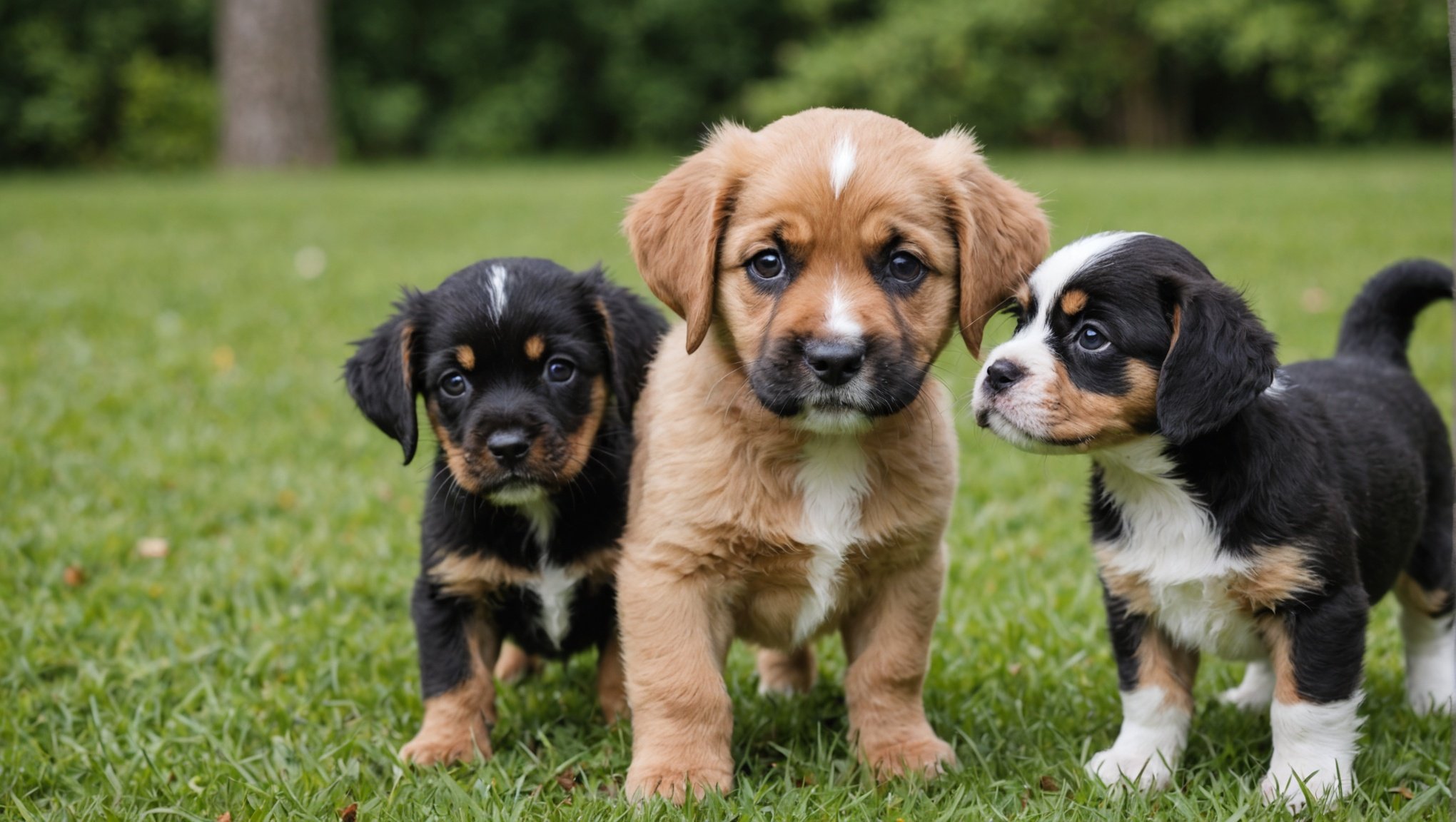Ultimate Guide to Successfully Socializing Your Puppy with Other Pets: Expert Tips and Best Practices
Why Socialization is Crucial for Your Puppy
Socialization is one of the most critical aspects of raising a well-adjusted and confident puppy. It involves exposing your puppy to a variety of new people, pets, environments, and experiences to help them develop good social skills and reduce the risk of anxiety or aggression later in life.
“Socialization is key to helping your puppy become confident and calm in new situations,” says a veterinarian from Pet Insurance Review. “The earlier you start, the better. Puppies are most receptive to new experiences between 8 and 16 weeks of age, so make the most of this period”.
This might interest you : The Ultimate Guide to Choosing the Best Bedding for Horses with Sensitive Skin
How to Socialize Your Puppy with Other Dogs
Socializing your puppy with other dogs is essential for teaching them how to interact politely and safely. Here are some expert tips to help you through this process:
Start with Basic Obedience Training
Before you let your puppy play with other dogs, it’s vital to ensure they have basic obedience training. This includes commands like “sit,” “stay,” and “come.” These commands will help you maintain control and ensure your puppy’s safety during interactions with other dogs.
Also to see : Mastering Loose Leash Walking: Top Strategies for Training Your Dog
“For example, when your dog is distracted by and playing with other dogs, will it still be able to respond to your commands? If not, then it is time to stop playing in the park and work on obedience training,” advises Dogster.
Plan Your Introductions Carefully
Never let your puppy off the leash to meet new dogs without a planned introduction. Here’s a step-by-step guide to a safe and successful introduction:
- Neutral Location: Choose a neutral, outdoor area with a fence or a quiet park where your puppy can meet other dogs without feeling overwhelmed.
- Leash Control: Keep both dogs on leashes initially and allow them to sniff each other from a distance.
- Body Language: Observe the body language of both dogs. If they appear relaxed and friendly, you can gradually reduce the distance between them.
- Off-Leash Interaction: Once both dogs seem comfortable, you can let them off their leashes under close supervision.
“Begin by allowing the dogs to walk closer toward each other, so they can smell each other. Next, bring the dogs together and walk side by side for a few feet. Reduce the distance between the dogs if their body language is friendly and loose,” recommends Dogster.
Allow Alone Time
Socialization is important, but so is giving your puppy time to rest and be alone. This helps them reset and prevents overstimulation.
“Although you may imagine a playtime that lasts all day, it is important to allow your dog some downtime in order to reset and settle,” advises Dogster. “If you’re introducing a new dog in your home, it helps to set it up with its own space initially. This could be a crate, room, or a small space within a room”.
Socializing Your Puppy with Other Pets and Animals
Socializing your puppy is not just about other dogs; it’s also crucial to introduce them to other pets and animals to ensure they are well-adjusted in various environments.
Introducing Your Puppy to Your Cat
Introducing your puppy to your cat requires patience and careful planning. Here are some steps to follow:
- Separate Spaces: Keep your puppy and cat in separate rooms initially to allow them to get used to each other’s scents and sounds without the stress of a face-to-face encounter.
- Gradual Introduction: Once they seem comfortable with each other’s presence, it’s time for a supervised meeting. Start with visual introductions through a door or gate, then progress to short, controlled meetings in the same room.
- Positive Reinforcement: Reward both pets for calm behavior. If either pet shows signs of aggression or fear, separate them immediately and start the process again from the beginning.
“Change environments and expose them to a variety of sounds, smells, and experiences. Take them to parks, pet stores, busy streets, and friends’ houses, and they will grow comfortable in many settings,” suggests The Dog Kennel Collection.
Creating a Socialization Plan
Developing a comprehensive socialization plan is key to ensuring your puppy receives the right amount of exposure to new experiences.
Daily Walks and Outings
Regular walks and outings are essential for socializing your puppy. Here are some tips:
- Diverse Environments: Take your puppy to different locations such as parks, pet stores, and busy streets to expose them to various sights, sounds, and smells.
- Meet New People: Introduce your puppy to new people, including children, adults, and people with different appearances (e.g., hats, glasses).
- Interactive Toys and Playdates: Use interactive toys and organize playdates with other pets to keep your puppy engaged and social.
“Regular play dates with friends, neighbors, or family members who have pets can be very beneficial,” advises Pet Insurance Review. “Daily walks and outings also help in socializing your puppy”.
Practical Tips for Successful Socialization
Here are some practical tips to help you socialize your puppy effectively:
Start Young
Begin socialization as early as possible. The critical period for socialization is between 8 and 16 weeks of age.
“Begin young; the sooner you get them around other animals/humans, the quicker they will improve their social skills,” emphasizes The Dog Kennel Collection.
Be Consistent
Consistency is key in socialization. Ensure that your puppy has regular interactions with other pets and people.
“Consistent positive experiences with their owner, such as playtime, training sessions, and cuddles, help to reinforce the bond and solidify your pup’s recognition of you as their owner,” notes The Dog Kennel Collection.
Observe Body Language
Always observe your puppy’s body language during social interactions. If they appear stressed or anxious, it’s time to take a step back.
“Seek out situations early on where your young pup can get used to all kinds of animals and feel calm, relaxed and relatively disinterested around them,” advises Modern Dog Magazine.
Table: Comparing Different Socialization Methods
| Method | Description | Benefits | Challenges |
|---|---|---|---|
| Daily Walks | Taking your puppy on regular walks to various locations. | Exposes puppy to diverse environments, people, and other animals. | Requires consistent time commitment. |
| Play Dates | Organizing playdates with other pets. | Helps puppies learn to interact with other animals. | Needs careful planning to ensure safe interactions. |
| Pet Daycare | Enrolling your puppy in pet daycare. | Provides social interaction with multiple pets in a supervised setting. | Can be costly and may not be suitable for all puppies. |
| Interactive Toys | Using toys that encourage interaction and engagement. | Keeps puppies engaged and stimulated. | May not provide the same level of social interaction as real-life encounters. |
| Training Classes | Enrolling in puppy training classes. | Offers structured socialization and training. | Requires a time commitment and can be expensive. |
Quotes from Experts
- “Socialization is key to helping your puppy become confident and calm in new situations. The earlier you start, the better.” – Pet Insurance Review
- “Seek out situations early on where your young pup can get used to all kinds of animals and feel calm, relaxed and relatively disinterested around them.” – Modern Dog Magazine
- “Consistent positive experiences with their owner, such as playtime, training sessions, and cuddles, help to reinforce the bond and solidify your pup’s recognition of you as their owner.” – The Dog Kennel Collection
Detailed Bullet Point List: Steps to Socialize Your Puppy
Here is a detailed list of steps to help you socialize your puppy effectively:
-
Begin Early:
-
Start socialization as early as 8 weeks of age.
-
Ensure consistent exposure to new experiences during the critical socialization period (8-16 weeks).
-
Introduce New People:
-
Expose your puppy to various people, including children, adults, and people with different appearances.
-
Encourage positive interactions by rewarding calm behavior.
-
Expose to New Environments:
-
Take your puppy to different locations such as parks, pet stores, and busy streets.
-
Introduce them to various sounds, smells, and experiences.
-
Socialize with Other Pets:
-
Organize playdates with other pets, including dogs, cats, and other animals.
-
Ensure safe and controlled interactions by observing body language.
-
Use Interactive Toys and Playdates:
-
Use interactive toys to keep your puppy engaged and stimulated.
-
Organize regular playdates with other pets to enhance social skills.
-
Enroll in Training Classes:
-
Consider enrolling in puppy training classes for structured socialization and training.
-
These classes can provide valuable guidance and social interaction in a supervised setting.
-
Provide Alone Time:
-
Ensure your puppy has time to rest and be alone to prevent overstimulation.
-
Set up a safe and comfortable space for your puppy to retreat to when needed.
By following these expert tips and best practices, you can help your puppy become a confident, well-adjusted member of your family and community. Remember, socialization is a continuous process that requires patience, consistency, and positive reinforcement. With the right approach, you can make sure your puppy grows into a happy and healthy dog.











